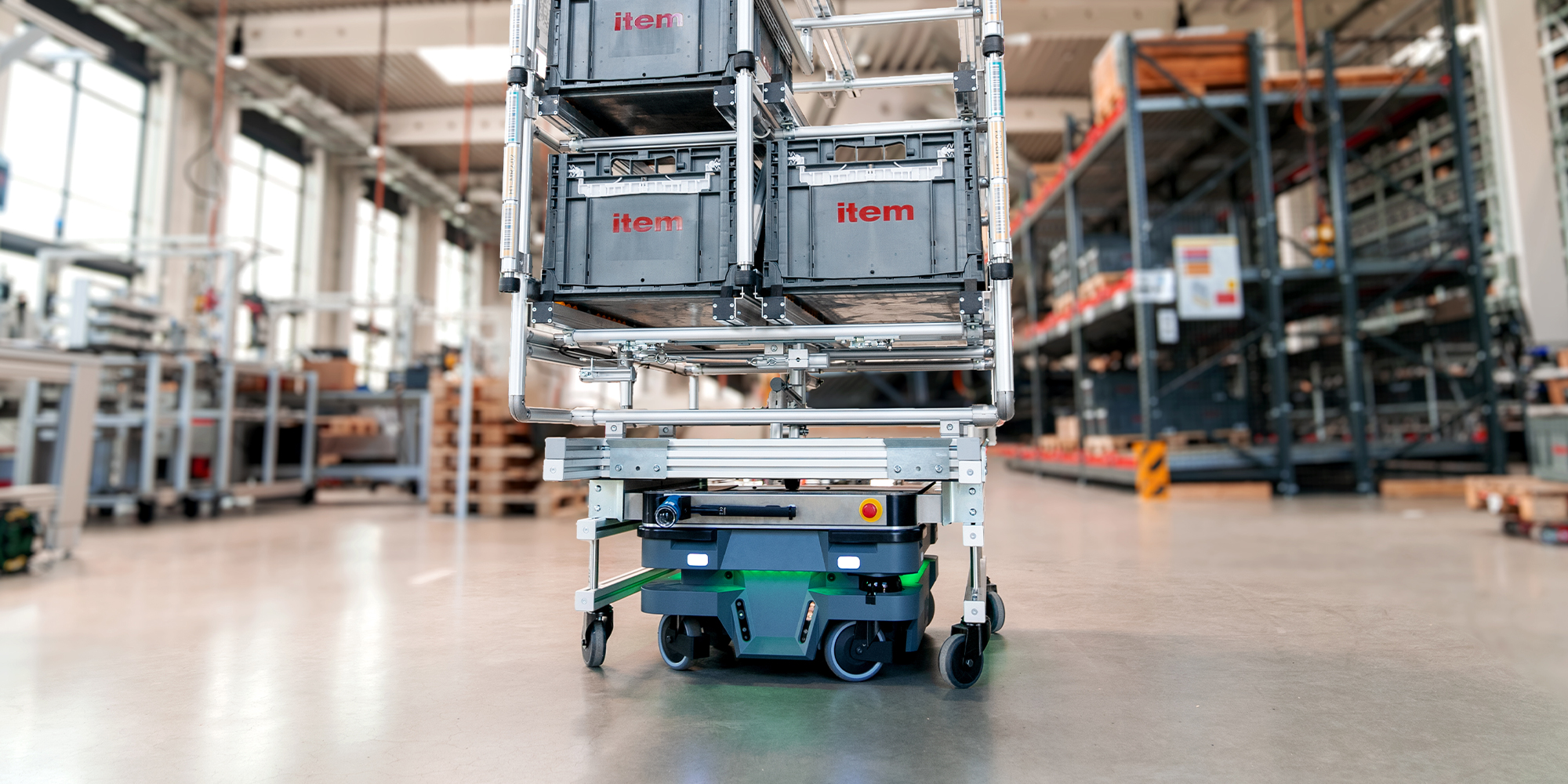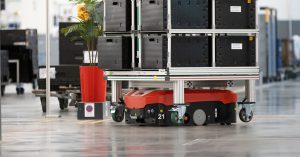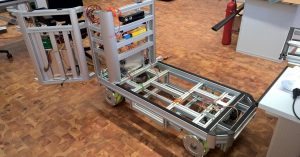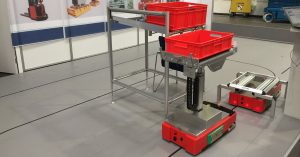The field of robotics covers much more than just industrial robots and cobots. For example, mobile transport robots offer a genuine advantage by taking over time-consuming intralogistics tasks.
Using AGVs or AMRs to automate transport tasks in intralogistics is a key step in easing the strain on staff. What’s more, material transport is one of the seven types of waste (muda) in lean production, a production philosophy that considers any activity which does not add value to be waste. After all, moving materials from place to place ties up important resources. By automating repetitive tasks such as these, companies can free up their staff to focus on the real work that generates value. Moreover, there is a pressing shortage of staff in the intralogistics sector. As a result of all these elements, mobile transport robots are becoming an increasingly common feature in intralogistics operations – both in industry and in eCommerce. The robots being used can often be categorised into two types – AGVs and AMRs. So what are the key features of each robot type? What are the main differences between them? And to what extent do these distinctions ultimately help a company decide on which type best fits its needs?
Automated guided vehicles (AGVs) – ideal for fixed routes and excellent reliability
Automated guided vehicles (AGVs) come in various shapes and sizes, for example to fit under trolleys, specialist superstructures or trailers, or to push or pull loads in a role similar to that of automated forklift trucks, tractors and lift trucks. In German-speaking countries, a distinction is made between a “driverless transport vehicle” (fahrerloses Transportfahrzeug or FTF), which is the individual vehicle and a “driverless transport system” (fahrerloses Transportsystem or FTS), which is a complete system comprising AGVs and a control station. The biggest distinction between an AGV and an AMR is its method of navigation. Unlike an AMR, an AGV is restricted to a fixed route. Although it can identify obstacles, an AGV can’t drive around them, and instead stops and waits until the obstacle has been removed. Fundamentally, an AGV therefore needs a special infrastructure that incorporates markings such as magnetic tapes, wires, QR codes or reflective markings.
The tasks and routes of AGVs also ultimately end up being simpler and clearer than in the case of AMRs, which benefits their dependability and safety.
Given the need for this additional infrastructure, any changes to the production environment and processes have a knock-on effect that results in extra outlay. However, the procurement costs for AGVs are usually lower than for AMRs, which use technology that is more complex, making them more expensive on the whole. AGVs do require some initial outlay for setting up the environment, although this is not necessarily a disadvantage. The key to deciding between an AGV and AMR is what the specific transport task and scenario require. For instance, if your scenario centres on routes that don’t change, or only change very little, and involve a low number of obstacles, then an AGV could prove more cost-efficient than an AMR. The tasks and routes of AGVs also ultimately end up being simpler and clearer than in the case of AMRs, which benefits their dependability and safety. Their routes and behaviour are a fixed, known quantity, which means staff know how best to act around them. They are particularly popular in the automotive industry. For example, Audi uses a combination of AGVs and supply trolleys built using item profile technology in the manufacturing operations for the Audi A8.
Autonomous mobile robots (AMRs) – especially flexible and versatile
Autonomous mobile robots (AMRs) have attracted particular attention in industry over recent years. The word “autonomous” indicates primarily that an AMR is not allocated to one specific route, but can instead adapt to its surroundings in real time. This adaptability is based on maps that are either uploaded to the system or are generated by the AMR itself. Using integrated cameras, scanners and sensors, the AMR automatically calculates the shortest route to its destination. If it encounters obstacles, for instance, this flexibility means that it doesn’t have to come to a stop and can instead find and take the best alternative route. If there are changes to its surroundings or if new working processes are introduced, the AMR can therefore adjust to them with ease. As they are not tied down to markings, there is no additional outlay associated with adapting routes. At the same time, AMRs cost more than AGVs because they utilise more complex hardware and software components, although their improved operational capabilities can offset these costs. All the same, it is always important to carefully consider the situation at hand.
As part of an in-house project to optimise its own intralogistics, item developed a base frame and a rack superstructure for AMRs from Mobile Industrial Robots (MiR).
Older distinctions between AGVs and AMRs have often emphasised that the latter are only suitable for transporting lightweight loads. Although AGVs do still have a slight advantage in this regard, special AMRs are now available that can transport payloads of up to 1350 kg. In contrast to AGVs, there are no lifting variants, although AMRs can also be fitted with a range of add-on modules and rack superstructures. For example, as part of an in-house project to optimise intralogistics in its European logistics headquarters, item developed two special constructions – a base frame made from the MB Building Kit System for the MiR250 AMR from Mobile Industrial Robots (MiR) and a rack superstructure, 90 percent of which is made up of components from the Lean Production Building Kit System. Having been successfully tested and put to regular use, these solutions are now available to item customers, too. Both constructions can be adapted to different MiR models and transport tasks. This is where the item Engineeringtool comes in very handy, as this example of a rack superstructure shows.
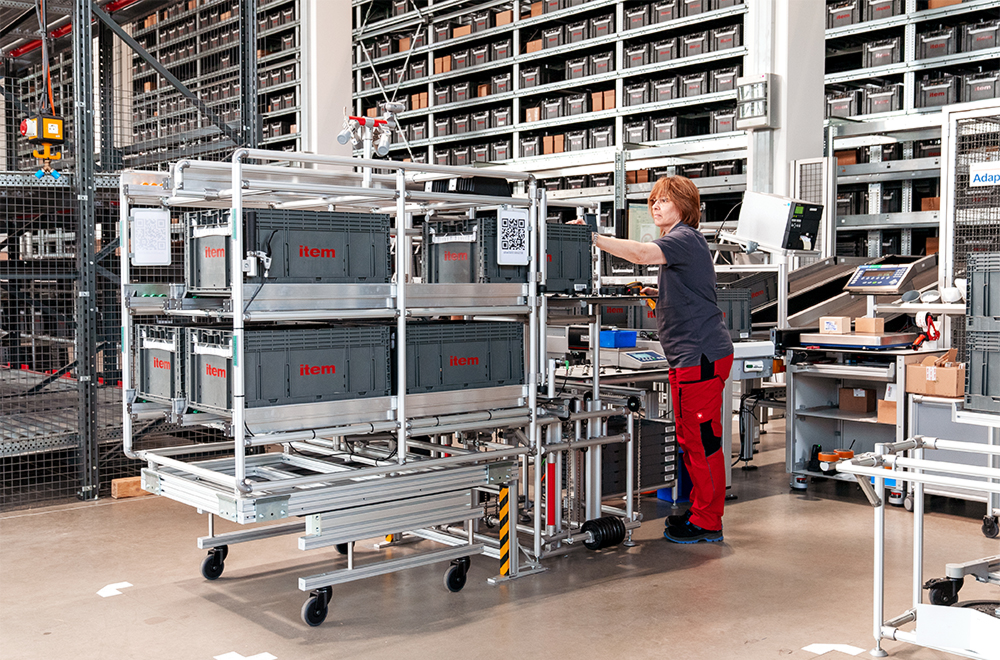
It’s all about the autonomy – AGV, AMR or mobile robot?
Mathias Behounek has a different take on the supposedly clear distinction between AGVs and AMRs. He is one of three Managing Directors of SAFELOG GmbH, which was established in 1996 in Markt Schwaben, Germany. Currently employing a workforce of 190, the company started out supplying picking systems and, since 2015, has had particular success with its agent-based mobile transport robots. Its customers include Mercedes, Audi, BMW, KUKA and ABB. SAFELOG pursues a dedicated software-based approach, choosing to omit countless components that are built into conventional AGVs and AMRs as standard. Although Behounek thinks manufacturers’ views of the AMR category make sense, he does not share their basic assumption: “The term ‘autonomous mobile robot’ is supposed to indicate that these robots have more freedom because, first and foremost, they are able to move around more freely in terms of navigation. This degree of freedom is measured in terms of autonomy. All the same, there are many other aspects that contribute to their autonomy.” Behounek is referring to the “Autonomy guidelines for mobile robots” issued (in German only) by the VDI Technical Committee for Driverless Transport Systems (VDI-Fachausschusses Fahrerlose Transportsysteme), which also contains an autonomy index for drawing up bespoke evaluations.
I would say that the degree of autonomy a mobile transport robot offers depends on how you evaluate the application scenario. There are countless different types of application out there and just as many ways of dealing with them.
In other words, the SAFELOG Managing Director believes that the autonomy of AMRs is overrated. For instance, a conventional AMR will usually only work with a fleet manager. Although an AMR is not restricted to a predetermined path in the same way an AGV is, there is still a whole range of dependencies to be met before it can fulfil its task. “We deliberately decided not to adopt the AMR categorisation. I would say that the degree of autonomy depends on how you evaluate the application scenario. There are countless different types of application out there and just as many ways of dealing with them. The most important thing is to keep it simple, then it’s easy to handle, stable and affordable,” says Behounek.
Want all the latest updates on innovative robotics applications? Simply subscribe to the item blog by completing the box at the top right.

